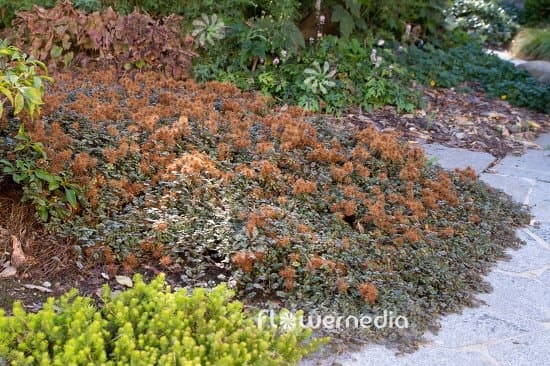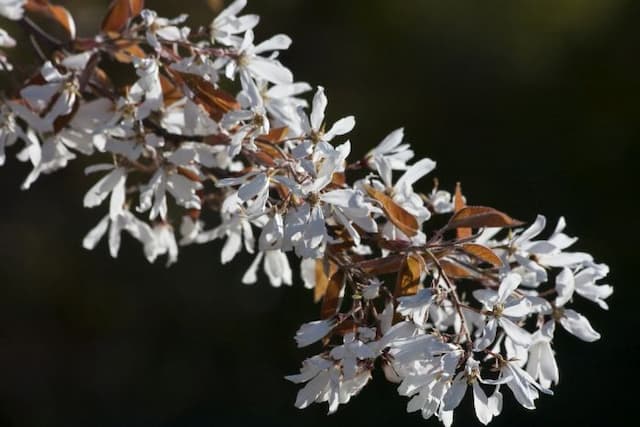Oullins Gage Plum Prunus domestica 'Oullins Gage' (C/d)

ABOUT
The Oullins Gage is a type of fruit tree that is well-known for its production of sweet gages, which are similar to plums. This tree produces lush, green foliage that is typically broad and ovate. The leaves provide a dense canopy, presenting a fresh, vibrant green hue during the growing season, which turns to lovely shades of yellow in the fall. In the spring, the tree is adorned with delicate, white blossoms. These blossoms are small, fragrant, and often appear in clusters, which add a delightful ornamental value to the tree. Following the blooming period, the tree sets fruit. The gages are golden-yellow with a sometimes flushed with a red or orange hue, particularly where they catch the most sun. The fruit's skin is smooth and has a bloomy surface when immature, but as the gages ripen, they become more translucent. Inside, the flesh of the gages is usually golden-yellow and very juicy. It's known for its rich, sweet flavor which makes the fruit highly desirable for fresh eating and for culinary uses such as in jams, preserves, and desserts. The fruit typically has a single, large pit in the center, which falls away from the flesh when it's fully ripe. The overall appearance of the Oullins Gage fruit tree is that of a quintessential lush fruiting tree that brings both aesthetic beauty and practical fruit production to a garden space.
About this plant
 Names
NamesFamily
Rosaceae
Synonyms
Oullins Gage Plum, Oullins Golden Gage, Yellow Gage
Common names
Prunus domestica 'Oullins Gage'
 Toxicity
ToxicityTo humans
The common name for Prunus domestica 'Oullins Gage' is plum. Plums, like other stone fruits, can contain cyanogenic glycosides, primarily in their pits, leaves, and stems. The fruit flesh itself is safe for human consumption. However, ingestion of large quantities of pits can lead to cyanide poisoning. Symptoms of cyanide poisoning include difficulty breathing, headache, dizziness, confusion, gastrointestinal distress, convulsions, and can be potentially fatal if not treated promptly.
To pets
The plum is known to be toxic to pets, including dogs and cats, if they consume the pits, leaves, or stems, which contain cyanogenic glycosides that can break down into cyanide when ingested. Consumption of these parts can lead to symptoms of poisoning such as dilated pupils, difficulty breathing, panting, lethargy, shock, and in severe cases, it can cause coma or death. Therefore, it is important to prevent pets from accessing the pits and other parts of the plum tree.
 Characteristics
CharacteristicsLife cycle
Perennials
Foliage type
Deciduous
Color of leaves
Green
Flower color
White
Height
12-15 feet (3.7-4.6 meters)
Spread
8-10 feet (2.4-3 meters)
Plant type
Tree
Hardiness zones
5
Native area
Europe
Benefits
 General Benefits
General Benefits- Edible Fruit: Produces delicious gage plums that can be eaten fresh, cooked, or preserved.
- Landscape Beautification: Oullins Gage plum trees have an aesthetically pleasing structure with blossoms that enhance garden visual appeal.
- Pollination Support: Attracts bees and other pollinators, thus contributing to a healthy ecosystem.
- Shade Provision: Mature trees can provide shade, creating cool spots in gardens during warm months.
- Culinary Uses: The fruit is versatile in cooking, used in pies, jams, and various recipes.
- Sustainable Gardening: Suitable for permaculture and organic gardening, promoting sustainable practices.
- Wildlife Habitat: Offers food for birds and other wildlife, supporting local biodiversity.
- Local Economic Value: Growers can sell the fruit at markets, contributing to local economies.
- Educational Opportunities: Can be a teaching tool for horticulture and fruit cultivation practices.
- Seasonal Interest: Provides a changing landscape throughout the seasons, from blossoms to fruit to autumn foliage.
 Medical Properties
Medical PropertiesThis plant is not used for medical purposes.
 Air-purifying Qualities
Air-purifying QualitiesThis plant is not specifically known for air purifying qualities.
 Other Uses
Other Uses- Oullins gage plum wood can be used in woodworking and crafting, particularly for creating small decorative items or in marquetry due to its attractive grain and color.
- The flowers of the Oullins gage plum can be used in floral arrangements to provide a springtime aesthetic, as they bloom beautifully and add a natural touch to decor.
- Leaves from the Oullins gage plum can be used to create natural dyes for fabrics, with shades varying depending on the mordant used.
- Pits of the Oullins gage plum can be cold pressed to extract an oil that may be used in homemade cosmetics or as a carrier oil in aromatherapy.
- The tree can serve as a host for beneficial insects, which can help balance the ecosystem of a garden and control pest populations.
- Oullins gage plum can be utilized in the production of fruit vinegar, providing a unique flavor profile for culinary use.
- Fallen fruit can be left on the ground to ferment and create a natural yeast trap, attracting wild yeasts for homemade bread or brewing purposes.
- Fresh Oullins gage plum fruit can be used to make a natural, pectin-rich jam or jelly without the need for added commercial pectin.
- The dense foliage of the Oullins gage plum tree can provide shade and cooling to smaller plants or seating areas within a garden during hotter months.
- When planted in a row or as part of a hedgerow, the Oullins gage plum can act as a windbreak, protecting soil and nearby plants from erosion or damage.
Interesting Facts
 Feng Shui
Feng ShuiThe European plum is not used in Feng Shui practice.
 Zodiac Sign Compitability
Zodiac Sign CompitabilityThe European plum is not used in astrology practice.
 Plant Symbolism
Plant Symbolism- Abundance: Prunus domestica 'Oullins Gage', commonly known as Oullins Gage plum, is a fruit-bearing tree that produces plentiful and delicious fruits. Its symbolism of abundance stems from the rich harvests it yields.
- Fertility: Similar to many fruit trees, the Oullins Gage plum is often associated with fertility and growth. This is due to its ability to produce fruit and propagate new trees, which is often seen as a sign of life and continuation.
- Renewal: With the plum tree's cycle of blossoming in spring, producing fruit in summer, and going dormant in winter, it symbolizes the cycle of renewal and the idea of rebirth and new beginnings.
- Wealth: The abundance of fruit provided by the Oullins Gage plum can also symbolize wealth, not just in the literal sense of a bountiful harvest, but also in a more figurative sense of richness in life experiences and personal growth.
 Water
WaterOullins Gage plum trees require thorough watering to establish deep root systems, especially during their first growing season. Water them deeply once a week, providing about 2 gallons per tree unless rainfall is sufficient. During dry spells in the summer, increase watering to twice weekly. Avoid shallow watering, which promotes weak root growth. Mature trees typically need less frequent watering, but during prolonged dry periods, they should receive additional water to maintain fruit production and overall health.
 Light
LightThe Oullins Gage plum tree flourishes in full sunlight, which means it should receive at least 6 to 8 hours of direct sun per day. Choose a planting spot that is free from shadows and away from taller structures or trees that could create significant shade. Adequate sunlight is essential for the tree to yield a good crop of plums.
 Temperature
TemperatureThe ideal temperature range for the Oullins Gage plum tree is between 35°F and 75°F. This variety is hardy and can survive winter temperatures down to about -10°F, but the blooms are vulnerable to late spring frosts. During the growing season, it is important to avoid exposing the tree to temperatures above 95°F, which can stress the plant and affect fruit production.
 Pruning
PruningPrune Oullins Gage plum trees in late winter or early spring when they are still dormant to remove dead or diseased wood, thin crowded branches, and maintain a strong structure. This annual pruning will improve air circulation and light penetration, which are essential for fruit quality and tree health. It's also an opportunity to shape the tree for better growth, and to remove suckers and water sprouts that draw energy away from fruiting branches.
 Cleaning
CleaningAs needed
 Soil
SoilOullins Gage plum trees thrive in well-draining, fertile soil with a pH of 5.5 to 6.5. A mix of garden soil, compost, and loamy soil is ideal for providing the necessary nutrients and drainage.
 Repotting
RepottingOullins Gage plum trees, grown in containers, should be repotted every 2-3 years to ensure they have ample space for root growth and to replenish nutrient-rich soil.
 Humidity & Misting
Humidity & MistingOullins Gage plum trees are quite adaptable but prefer average humidity levels that are typical of outdoor environments. They do not have specific high humidity requirements.
 Suitable locations
Suitable locationsIndoor
Not ideal for indoors; requires sunlight and space.
Outdoor
Plant in sunny spot, protect from strong winds, ensure soil drains.
Hardiness zone
5-9 USDA
 Life cycle
Life cycleOullins Gage plum begins its life cycle when a seed germinates in the soil, typically requiring a period of cold stratification to break dormancy. After germination, the seedling grows through vegetative stages, developing a root system and shoots with leaves. As it matures into a sapling and then a fully-grown tree, it develops a woody structure capable of supporting the weight of fruit. Flowering usually begins in early spring; the blossoms are pollinated by insects, leading to fruit development. The tree enters a stage of fruit maturity in late summer, where the plums ripen and can be harvested. During the dormant season in winter, the tree conserves energy to begin the cycle again in the following spring.
 Propogation
PropogationPropogation time
Spring to Summer
The most popular method of propagation for the Oullins Gage plum, a variety of Prunus domestica, is through grafting, which is commonly done in late winter or early spring. Grafting involves taking a healthy scion, which is a young shoot or twig from the desired plum tree, and attaching it to a compatible rootstock of another Prunus species. The scion should be about 4 to 8 inches long (10 to 20 centimeters) with several buds on it. The rootstock, which provides the root system for the grafted tree, should be chosen for its adaptability to the local soil and climate as well as for its disease resistance. The cut surfaces of both the scion and the rootstock are joined together and tightly bound with grafting tape; this union must be kept moist until the graft has taken and the scion has started to grow, which indicates that the graft is successful.

![Tree amelanchier [Tradition]](/_next/image?url=https%3A%2F%2Fplants-admin.emdemapps.com%2Fimages%2Fplants%2F%2Fimages%2F604b56afa99a2.png&w=640&q=75)




![Strawberry [Just Add Cream]](/_next/image?url=https%3A%2F%2Fplants-admin.emdemapps.com%2Fimages%2Fplants%2F%2Fimages%2F604b5f8e7d168.png&w=640&q=75)


